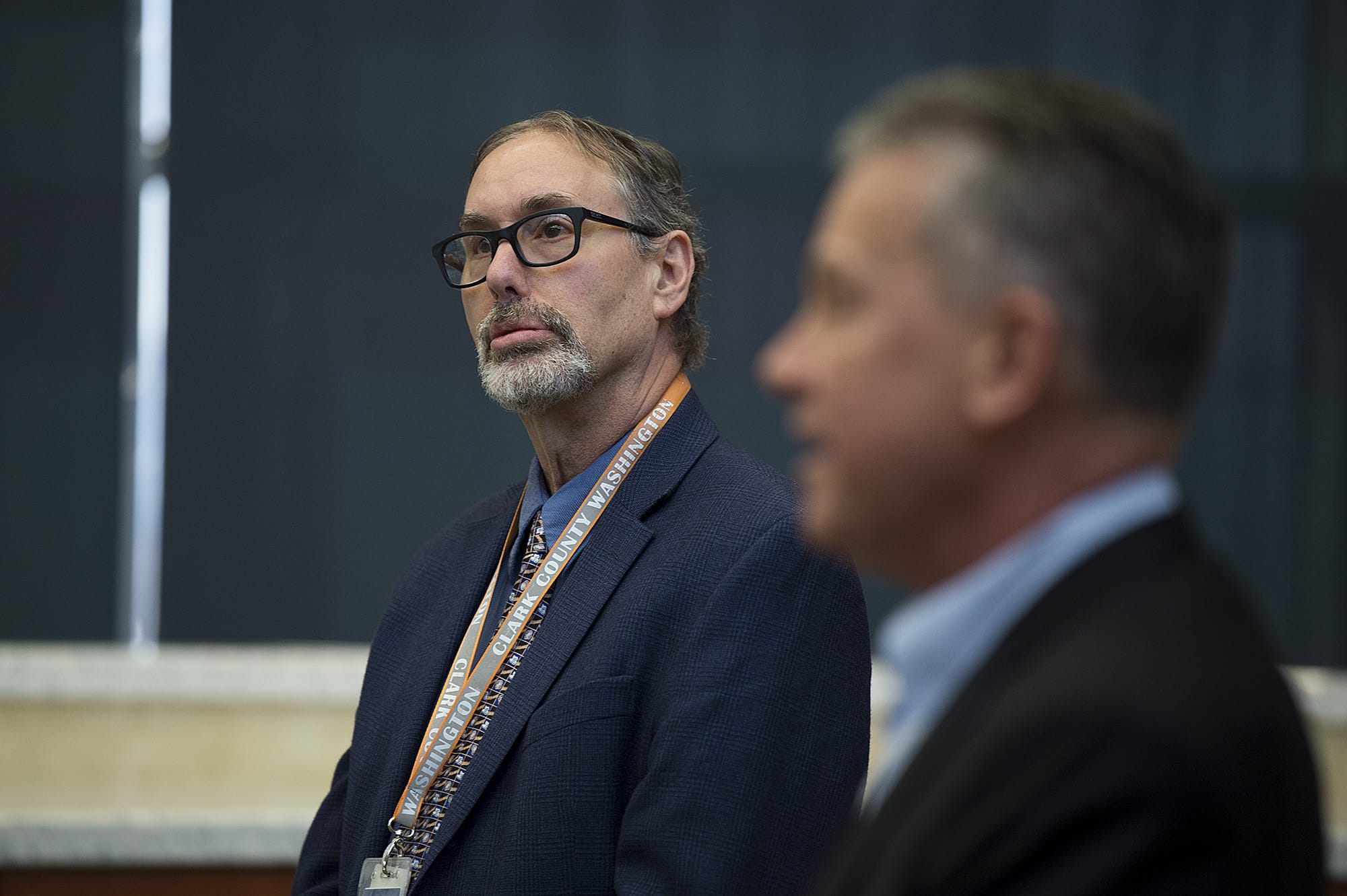As COVID-19 rates increase in Clark County, one of the county’s top officials pushed back against broad scientific consensus and challenged public health efforts promoting the use of face coverings to reduce the spread of the disease.
Clark County Council Chair Eileen Quiring O’Brien said she has been told by doctors that there is evidence that wearing face coverings does not help reduce the spread of the novel coronavirus.
Her comments came during Wednesday’s Board of Health meeting after Clark County Public Health Officer Dr. Alan Melnick said that wearing face coverings and keeping physical distance are the quickest ways back to normalcy, before a vaccine arrives.
“There’s also evidence contrary to that. We hear it,” Quiring O’Brien said. “It’s frustrating to me because I hear the opposite, Dr. Melnick. That masks really don’t help, and I don’t think it’s junk science. I just think it’s a difference of opinion.”
‘Powerful’ weapon against virus
The effectiveness of face coverings has been the subject of numerous studies. The Centers for Disease Control and Prevention in July called on all Americans to wear face masks in an effort to reduce the spread of COVID-19.
“We are not defenseless against COVID-19,” CDC Director Robert Redfield said at the time. “Cloth face coverings are one of the most powerful weapons we have to slow and stop the spread of the virus — particularly when used universally within a community setting. All Americans have a responsibility to protect themselves, their families, and their communities.”
In July, the CDC referenced two different studies supporting the effectiveness of face coverings. One published in The Journal of the American Medical Association showed that universal masking policies reduced coronavirus transmission within a Boston hospital system.
Another study from the CDC’s Morbidity and Mortality Weekly Report showed that wearing a mask prevented the spread of infection from two hair stylists to their customers in Missouri.
The stylists with confirmed COVID-19 infections wore face coverings during their appointments, and 98 percent of their clients did, too. They came in contact with 139 people (clients and other close contacts), and none of those 139 people became ill.
Nearly 70 of those 139 contacts and clients agreed to be tested for coronavirus, and none of them registered positive tests.
“The best way that we can really get these numbers down is if we practice physical distancing and masking,” Melnick said at the meeting. “If we had 95 percent of the population consistently practicing masking, we’d be way down in terms of the cases.”
Tension over message
The back and forth between Melnick and Quiring O’Brien created tension.
Clark County Councilor Gary Medvigy, who has said he supports the science around face coverings and physical distancing, was critical of Melnick’s responses when it comes to ideas or inquiries from the council.
“At least from my point of view as a member sitting on this board, there seems to be only one conduit, and that’s you, and we kind of get, ‘Talk to the hand’ as far as a response,” Medvigy said.
At that moment, someone watching the virtual meeting audibly gasped: “What?” in what seemed like a sense of bewilderment.
Wednesday’s meeting included frustrations over the criteria Washington is using to allow counties to move into Phase 3 of the state’s COVID-19 recovery plan.
Quiring O’Brien said the state should change its grading criteria. In an April council meeting, only one month after coronavirus officially arrived in Clark County, Quiring O’Brien said she wanted the county to explore ways to reopen at a faster pace than Gov. Jay Inslee’s plan called for.
A lawyer for Clark County told Quiring O’Brien that was not legally feasible.
“The natives are restless,” Quiring O’Brien said at that time. “There are a lot of people who want to be done with this.”
Quiring O’Brien pushed a similar idea again at Wednesday’s meeting.
“I think every one of these criteria should be re-looked at,” she said. “I want to know how we, as the Board of Health, can ask for the state, or you as our Public Health director, can push for different criteria? These criteria need to be reachable. We will never reach whatever the state is asking us to reach if we maintain this criteria.”
Melnick acknowledged that contact notification goals have been hard to reach. The county has still not met each goal the state requires for entering Phase 3.
According to data from earlier this month, Public Health has only made contact with 54 percent of confirmed cases within 24 hours of a positive test, well below the 90 percent target. They have also only reached 21 percent of close contacts of a confirmed case within 48 hours of a positive test, below the 80 percent target.
Public Health has been able to reach 74 percent of confirmed cases every day during their isolation period and 41 percent of close contacts for every day of their quarantine period. Both metrics are below the 80 percent target.
Melnick said the state Department of Health has also struggled in contact notification for local jurisdictions they’ve helped with the task.
According to data for 551 confirmed cases between Aug. 23 and Sept. 5, the department of health only reached 50 percent of cases within 24 hours.
The department of health did reach 70 percent of close contacts within 48 hours, but Melnick said he thinks the department of health might only be counting close contacts of confirmed cases that the department of health have interviewed, instead of all close contacts, which is a harder criteria and one Public Health uses.
This potential discrepancy in metrics upset multiple councilors. Public Health might only be reaching a smaller percentage of close contacts, but they are leaving voicemails and text messages for a high majority, which Clark County Councilor Julie Olson said should count in the metrics. Olson also said the state needs to be on the same page as its counties.
“Every time we have a difference in how we calculate anything and it’s not consistent, it degrades the public’s confidence in any of the numbers we report,” she said.
Disease activity rising
Melnick agreed with Olson about discrepancies, but said the most concerning metrics weren’t around case notification, but were about the increasing COVID-19 activity in the community.
Recent testing data shows Clark County returning 5.12 percent of tests as positive. In the middle of the summer, that metric was below 2 percent.
The increased case counts in September pushed back school openings Tuesday as Clark County rose into the “high” COVID-19 activity range.
On Wednesday, Clark County recorded 34 new COVID-19 cases and one new fatality, a woman age 80 or older with no underlying conditions. Clark County has 3,240 confirmed cases and 55 deaths to date.
The county has averaged 33 new cases a day, since Friday, according to Public Health data.
There are 156 active cases, and 29 people hospitalized with COVID-19. Six people are hospitalized and awaiting test results, according to Public Health.
The most recent test data shows that testing totals have decreased by about 12 percent in each of the weeks ending on Aug. 29 and Sept. 5, but the percent of positive of tests rose by 18 and 50 percent in those weeks, respectively.
Councilman John Blom said that everyone has a responsibility to protect others. He said people who blatantly gather in large groups and don’t wear masks or physical distance are disrespecting health care workers and the community with their behavior.
“There’s a reason that other parts of the world are doing a better job of handling it,” Blom said. “They’re doing a better job of social distancing and masking and they are handling the disease. We can’t just change the metrics and say that everything is good.”




